Review: The Seagull

| Location | 2055 S Sepulveda Blvd, Los Angeles, CA 90025 |
| Theater | The Odyssey Theatre, Los Angeles |
| Date of Performance | January 18, 2025 |
| Language(s) | English (translated from Russian) |
| Photos by | Sasha Dawson and Miguel Perez |
Reviewed by Amanda L. Andrei
“We need new forms,” declares Konstantin Treplev, a fledgling playwright and son of an aging actress, of the theatre. “New forms are needed, and if we can’t have them, then we had better have nothing at all.” It’s also through old forms, such as Anton Chekov’s comedy The Seagull, that audience members can contemplate the role of artists and the snares of love. Although Odyssey Theatre Ensemble’s vision of this play contains stylistic twists which belie Chekov’s realism and create an undercurrent of dissonance, the poised portrayals of the iconic Boris Trigorin and Irina Arkadina bolster the tragicomedy.

Dramatist and author Anton Chekov penned The Seagull 130 years ago, with its premiere a year later, in 1896 at the Alexandrinsky Theatre in St. Petersburg, Russia. Set in a lake house and estate in the Russian countryside in the same era, the play served as an opportunity for the turn-of-the-century audiences to see themselves reflected in stark, realistic terms: family dynamics, class differences, and love triangles during a shimmery summer and then two years later, in a thunderstorm.
There’s Irina Arkadina (Sasha Alexander), a theatre actress trying to reclaim her youth and influence, visiting her brother Pyotr Sorin (Joe Hulser), retired official and owner of the lake house. Her son Konstantin (Parker Sack), living under the shadow of his mother and aspiring to be a writer. Boris Trigorin (James Tupper), established writer and paramour of Irina, who falls for the 19-year-old idealistic Nina Zarechnaya (Cece Kelly), a neighbor to the estate who longs to be an actress and in the world of theatre and literati. And then there are multiple other guests, neighbors, and servants who add to the rich texture and intrigue of Russian society.
It would be easy to paint Trigorin as a slimy creep, preying on a teenage Nina for his own base desires and insecurities. But James Tupper is exquisite, inhabiting the role with such innocent presence and care that it’s easy to be seduced by—and sympathetic towards—this romantic writer. Sasha Alexander also fills her Irina with vigor and desperation, drawing bursts of laughter with her comedic timing and commanding rapt attention as she baits Trigorin to return to her arms. Parker Sack as Konstantin offers boyish rebellion, optimism, and moodiness—he shines best during a verbal throwdown with his rapacious mother—though witnessing a more transformative arc towards the end would have been more satisfying and poignant. Performances by Will Dixon as Dr. Dorn, and Carlos Carrasco as the steward Shamrayev, are also notable for the gusto and enthusiasm they bring to these side characters.
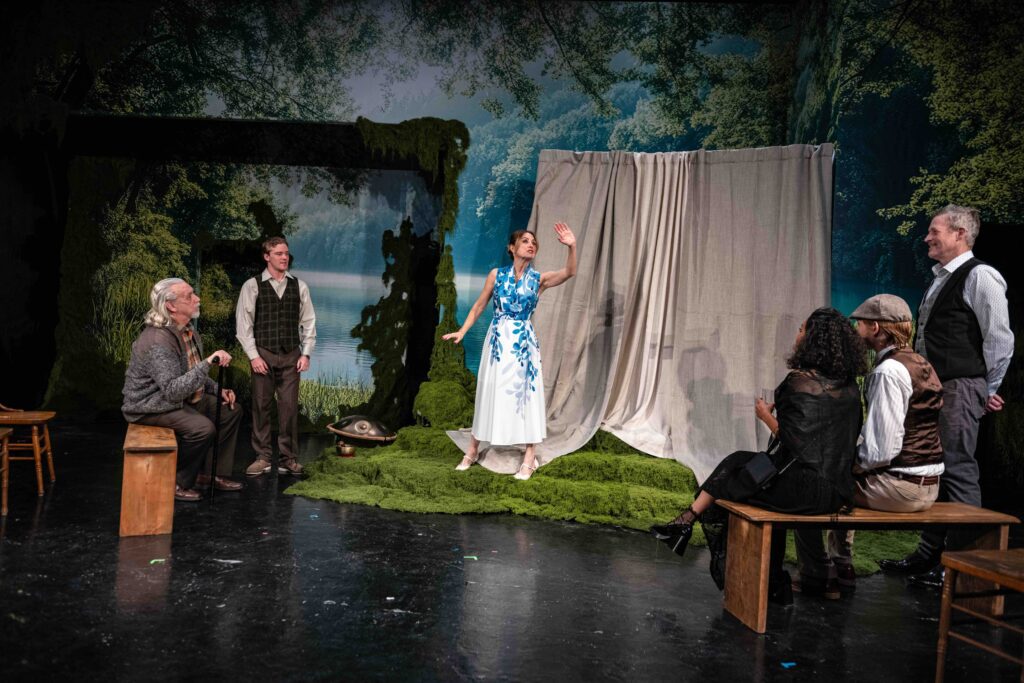
by the lake. Photo credit: Miguel Perez.
Part of the trouble with this production is that some of the visual stylistic choices conflict with the realism and era invoked from the text, a translation from 1960 by Ann Dunnigan. The translation itself is clear, and occasionally feels dated with its exclamations and endearments (“Fiddlesticks!” “Little one!”), but the dated feeling seems to come more from the ambiguity around time and place within the production. It’s unclear what the time period is: costumes and props verge on the modern, and small details like sunglasses, a camouflage outfit, and a ballpoint pen impart anachronistic touches that distract. The sprawling moss and large aquamarine lake in the background (cleverly designed by Carlo Maghirang) evoke feelings of immersivity and stagnancy beneath beauty, but also give an expressionistic feeling, as if the house and action symbolically live within the lake, instead of alongside it.
Director Bruce Katzman also crafts some moments of characters freezing in charged moments, creating silent tableaus that adds a touch of strangeness to the production. The choice to get playful and more abstract with The Seagull is a noteworthy one, though it seems the production would benefit from a more modern or updated translation that would allow the creative team to be more flexible with the contemporary design choices and have a more unified vision.
Given the situation with the wildfires, it can be jarring to return to the theatres during this time in L.A. Chekov’s summer vacation world and love entanglements seem far removed from the disaster befalling the City of Angels. But in fact, they hearken to L.A. as the illusory La-la-land, that amidst the luster of the entertainment industry, there are scores of individuals who are dreaming, scheming, and hustling to make a life in the arts. Some motives may be naïve or petty, others heartfelt and sincere.
As Nina tells Konstantin towards the end, after her share of trials and heartbreak,
“I know now, I understand, that in our work, Kostya—whether it’s acting or writing—what’s important is not fame, not glory, not things I used to dream of, but the ability to endure.”
In this time, that endurance is a reminder for every Angeleno.
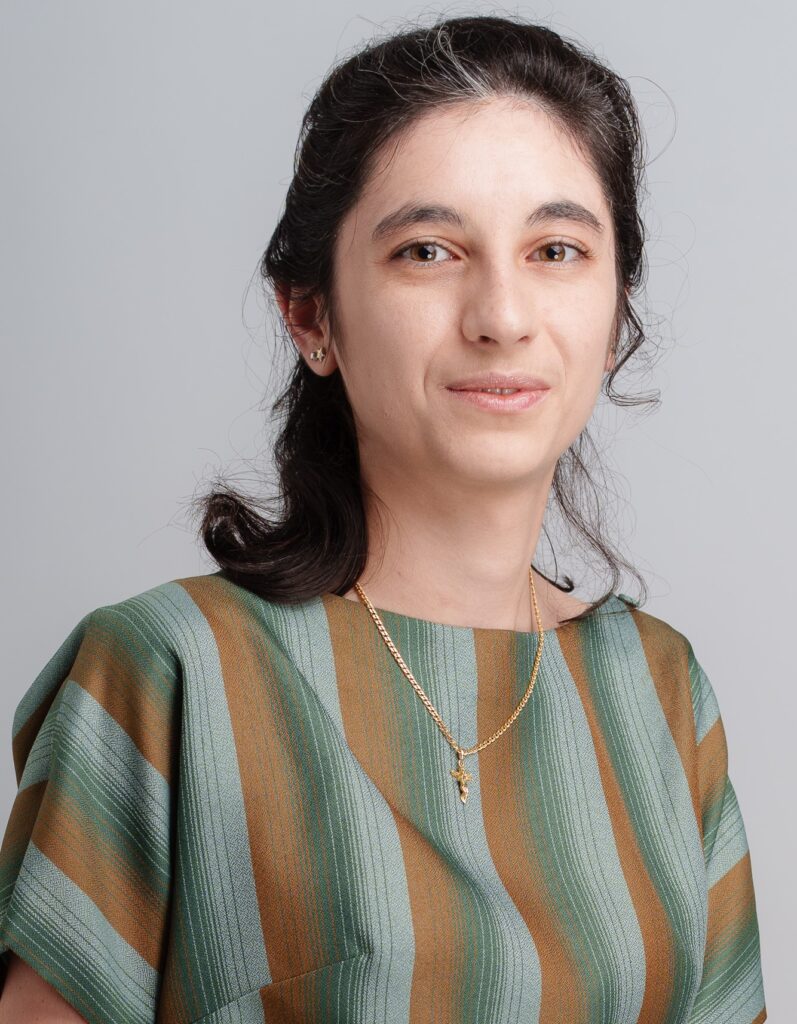
Ioana Bîrjan (b.1997) is the author of Vârsta Iubirii which translates into English as The Age of Love (Heyday Books, 2023). The novel is inspired by the Lady of the Camellias and the opera La traviata. She earned a bachelor’s degree from the Faculty of Letters, Ovidius University of Constanța, where she is now a graduate student in the Romanian Studies program.
Read more of her work in magazines, in anthologies, and on her blog: https://scrierileioanei.wordpress.com/
SUPPORT SEEFEST
Not a member yet? Become an art patron with other SEEfest arthouse aficionados in support of great events and programs. Our mission is to keep you informed about initiatives from our wide network of fellow cultural organizations.
We Welcome YOU!
Review: God of Carnage
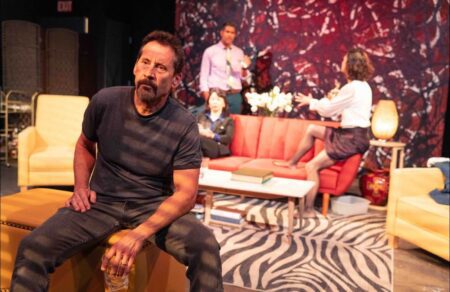
| Location | 905 Cole Theatre @ Anthony Meindl’s Actor Workshop – 905 Cole Ave, Los Angeles, CA 90038 |
| Theater | Thunderbird Garage Productions, Los Angeles |
| Date of Performance | September 15, 2024 |
| Language(s) | English (translated from French) |
| Photos by | Zadran Wali |
Reviewed by Amanda L. Andrei
Ah, modern-day parenting. Caring for children and pets, maintaining a household, negotiating politely with other stressed parents about whose child hit who and how and why and what the consequences will be… beneath the surface of civilized life, Yasmin Reza’s God of Carnage portrays the absurdity and anger between two pairs of parents dealing with a physical altercation between their children.
Le Dieu du Carnage originally premiered in Zurich in 2006. Later translated from French into English by Christopher Hampton, God of Carnage and its translations have had multiple productions around the world. The English translation, set in Brooklyn instead of Paris, opened on Broadway in 2009, and the story was adapted into a film, Carnage, which premiered in 2011 and was directed by Roman Polanski. Thunderbird Garage Productions remounts the play in the intimacy of a small L.A. theatre, dousing us in the agitation and discomfited humor of upper middle-class parents.
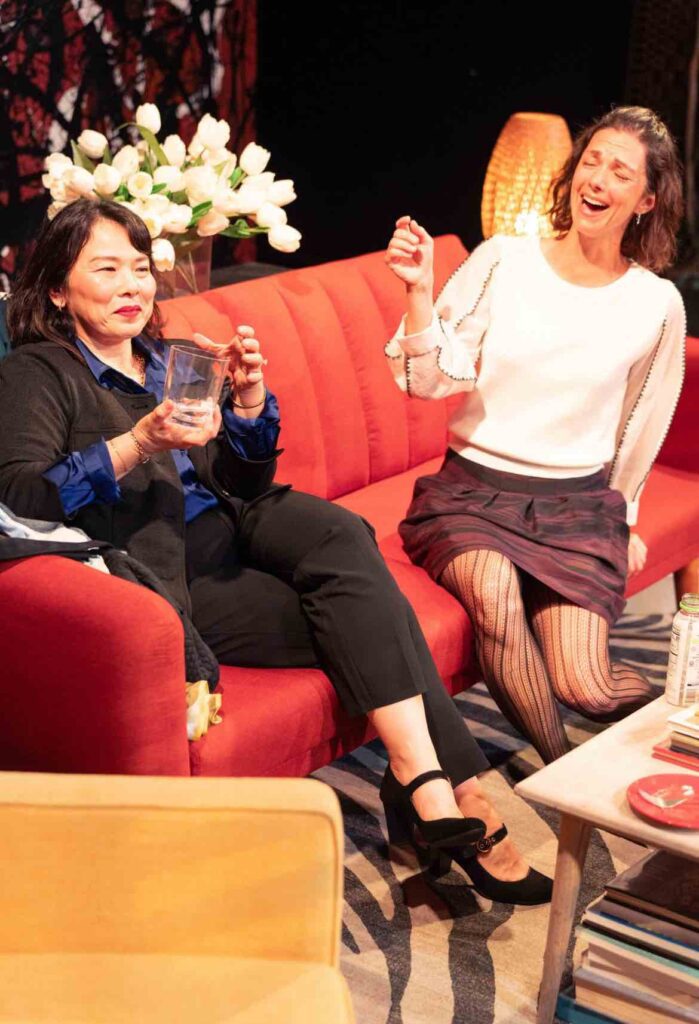
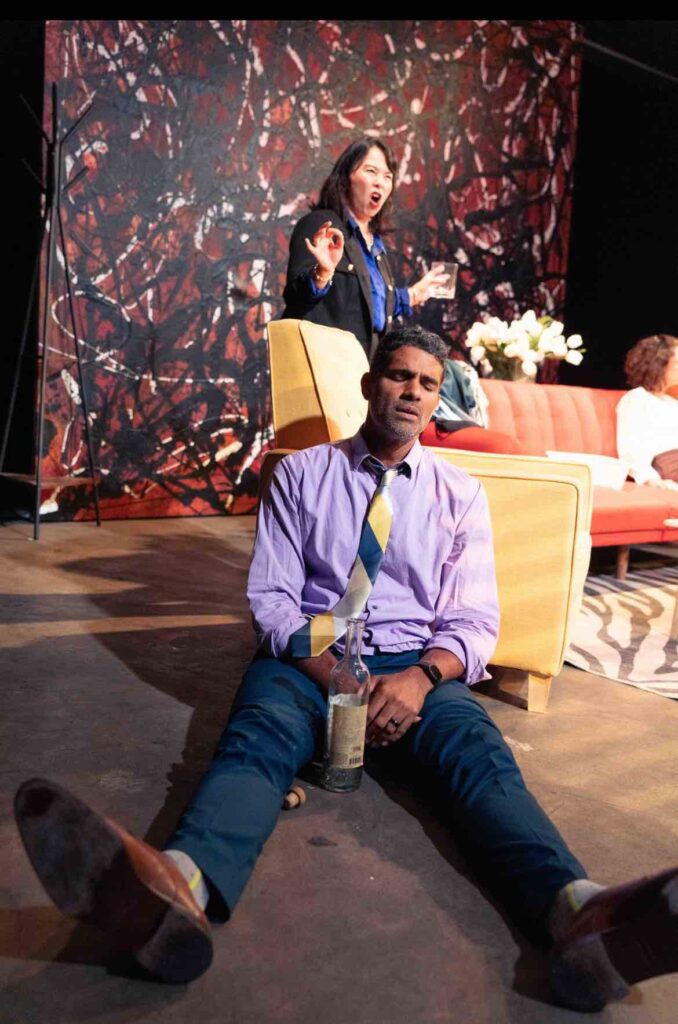
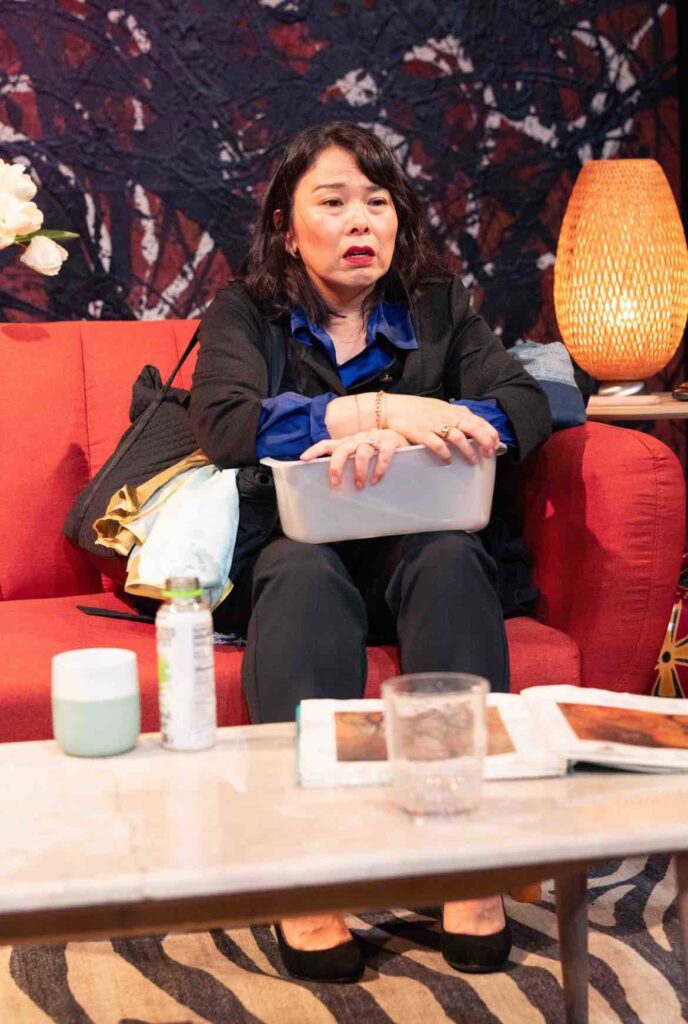
In the play, Michael (Eric Larson) and Veronica (Olga Konstantulakis) cordially host Alan (Kristian Kordula) and Annette (Andrea Lwin)–the parents of a boy who has just injured their son. Over espresso, clafouti, and verbal niceties, they gradually descend into shambles as their prejudices and judgmental behaviors are exposed. Under Kim Quinn’s direction, frustration and anger prevail at an intense volume, at times overpowering portrayals of disgust, resentment, and shock. The fury is more apt when dialogue explodes into action—Konstantulakis displays splendid rage when she pummels her husband, as does Lwin when she wreaks havoc on her husband’s phone. Kordula and Larson likewise draw laughs from the audience with their comedic timing and well-placed silences, adding sardonic texture to the baseline of ire.
The set is simple yet detail-oriented (built by Eric Larson), with modern art sculptures delineating the room and a massive black, white, and maroon abstract painting reflecting the characters’ collective internal chaos. Jacob Nguyen’s lighting design subtly tracks the realistic time of the play through Venetian blind shadows, while his pre-show and post-show music evokes the friction between modern day expectations and more subconscious forces at play.
Created by four friends from Larry Moss acting workshops, this show marks Thunderbird Garage’s first production. Though there’s room for more emotional nuance in the characters’ journeys, it’s a treat to see a contemporary classic staged with such spirited earnestness.
“Men are so wedded to their gadgets,” fusses Annette, “It belittles them.” An evening with carnage should help with that.

Ioana Bîrjan (b.1997) is the author of Vârsta Iubirii which translates into English as The Age of Love (Heyday Books, 2023). The novel is inspired by the Lady of the Camellias and the opera La traviata. She earned a bachelor’s degree from the Faculty of Letters, Ovidius University of Constanța, where she is now a graduate student in the Romanian Studies program.
Read more of her work in magazines, in anthologies, and on her blog: https://scrierileioanei.wordpress.com/
SUPPORT SEEFEST
Not a member yet? Become an art patron with other SEEfest arthouse aficionados in support of great events and programs. Our mission is to keep you informed about initiatives from our wide network of fellow cultural organizations.
We Welcome YOU!
Review: Transparent Body & Other Texts by Max Blecher
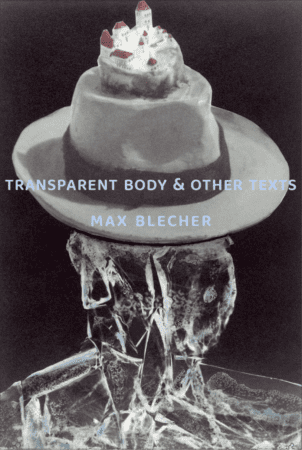
| Author | Max Blecher |
| Translated By | Gabi Reigh |
| Genre | Fiction, Poetry, Letters |
| Language(s) | Romanian |
| Format | 174 Pages |
| Publisher | Twisted Spoon Press |
| ISBN | 9788088628033 |
Reviewed by Amanda L. Andrei
The only thing more magical than receiving a letter from a friend is reading the letters of a writer you admire, and feeling as if they were sent to you. Translated from Romanian by Gabi Reigh, Transparent Body and & Other Texts collects poems, short prose, aphorisms, doodles, interviews—and best of all, letters—by the Romanian Jewish interwar writer Max Blecher. Reading Blecher’s work 80 years after his death feels as intimate and resonant as catching up with an old friend who has suffered and cared deeply.
Transparent Body was first published as a limited-edition release in 1934 when Blecher was 25 years old. By that time, he had been suffering from spinal tuberculosis for over 6 years, shuffling between various sanatoria before returning to his hometown in Botoșani, Romania. Despite his illness, he continued to write and publish texts that vibrate with urgency, intensity, and surrealism.
In the short triptych story “IX – MIX – FIX,” the narrator relates a bizarre scenario with emotional distance yet keen attention to the nightmarish physics that dissolves corporal and spiritual experiences into one. During one scene, he writes:
“I flew through chaotic chambers walled by bulbous, diseased clouds. I was hanging by the belly of a flying half-dog, my fingers digging into its flesh. But my legs were too long and, as they manically raced on the metal floor, metre-high sparks burst under my feet. Solitude chased me, flying towards me with a keener, sharper melancholy: I could no longer tell whether the rush of speed raced through my body or my soul.”
Blecher’s aphorisms also reflect cynical Romanian humor:
“Some people make others miserable by oppressing them, while others, conversely, by supporting them.”
Others, poetic despair:
“It is the magnetism of the abyss that looms over every conversation.”
Reading the list of aphorisms in one sitting feels a touch overwhelming: each maxim is a finely-cut gem of philosophy that deserves its own moment of contemplation.
The collection also has dozens of letters that reveal a different side of Blecher, more emotional and intimate, with humor that is less heavy and more sparkling.
In a letter dated May 16, 1930, to the French avant-garde poet Pierre Minet, he writes in response to a missed phone call from Minet about accidentally leaving a map in his carriage. The letter meanders to the 20-year-old Blecher describing his feelings of exasperated loneliness as he convalesces in the northern French commune of Bereck-sur-Mer. Some of his humor and frustration bursts out, provoking sympathy in the reader for this young artist who is deeply held back by his ill health and circumstances: “Of course, I am reliably informed that ordinary life is desperately idiotic, but I haven’t experienced it for myself!”
Other correspondence includes Blecher’s letters to other European literati such as Valerie Ionescu (editor of magazine Viața literatură), Alexandru Binder (editor of unu, which published works by other seminal Romanian modernist writers), and Geo Bogza (Romanian interwar avant-garde poet and early Surrealist). Blecher muses on his projects and artistic process, his family members and health, and his wishes and affection. Reigh’s translation beautifully portrays his vulnerability and shifting emotions, and an ample amount of footnotes in the correspondence provides more historical context for Blecher and his colleagues.
Although he passed away in 1938 at the age of 28, Blecher produced a stunning body of work in a short time. Transparent Body & Other Texts gives Anglophone literature an insight into a lesser-known avant-garde author—and not only through his surrealist fiction and prose, but to his struggles, doubts, and hopes.
Max Blecher’s novel Scarred Hearts was made into a film by one of the top Romanian filmmakers, Radu Jude.

Ioana Bîrjan (b.1997) is the author of Vârsta Iubirii which translates into English as The Age of Love (Heyday Books, 2023). The novel is inspired by the Lady of the Camellias and the opera La traviata. She earned a bachelor’s degree from the Faculty of Letters, Ovidius University of Constanța, where she is now a graduate student in the Romanian Studies program.
Read more of her work in magazines, in anthologies, and on her blog: https://scrierileioanei.wordpress.com/
SUPPORT SEEFEST
Not a member yet? Become an art patron with other SEEfest arthouse aficionados in support of great events and programs. Our mission is to keep you informed about initiatives from our wide network of fellow cultural organizations.
We Welcome YOU!
Review: Stalin’s Master Class
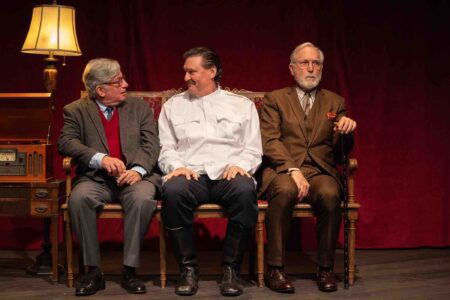
| Location | Odyssey Theater, Los Angeles, CA |
| Date of Performance | June 2, 2024 |
| Language(s) | English |
| Photos by Jenny Graham | Amanda L. Andrei |
Reviewed by Amanda L. Andrei
A kick to a cane and a man falls to his knees. A command to sing and fear fills the singers’ eyes. These small cruelties inhabit the spacious room of Stalin’s Master Class as the full terror of the regime stays subdued.
The lion’s share of danger resides with the historical figure of Josef Stalin, the Georgian dictator responsible for the deaths of millions across Eastern Europe as he consolidated power into the former Union of Soviet Socialist Republics (USSR or Soviet Union), a world superpower from 1922 to 1991. By the time this play was written in 1984 by British playwright David Pownall, the dictator had been dead for thirty years, the Soviet Union was entering an era of decline, and Cold War tension ran high with nuclear threat.
Odyssey Theatre’s restaging of this satirical drama is a fascinating choice for 2024, as the memory of Stalin has faded, but global concerns over authoritarianism and populism remain high.
Based on events from a musician’s conference in January 1948 at the Kremlin, where Secretary of the Communist Party Andrei Zhdanov summoned musicians and music critics to deride their aesthetics and adherence to formalism, Stalin’s Master Class extends and fictionalizes the scenario further. Zhdanov (John Kayton) invites two composers, Dmitri Shostakovich (Randy Lowell) and Sergei Prokofiev (Jan Monroe), to a private audience with Stalin (Ilia Volok) at the Kremlin. And an invitation from an autocrat is never just an invitation.
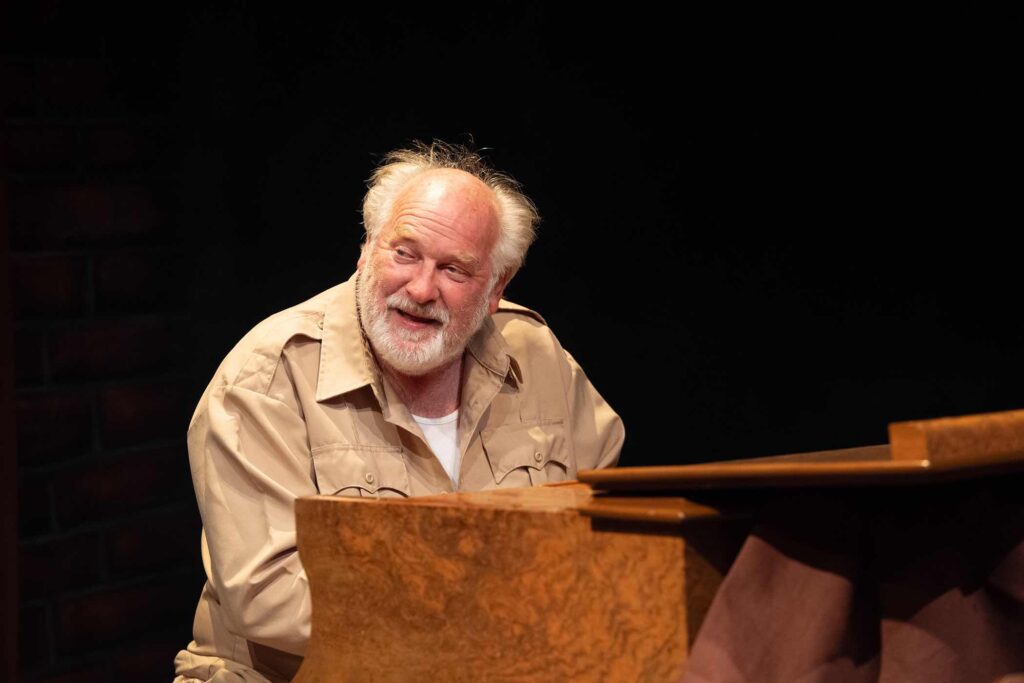

In this case, the invitation meanders between philosophizing about the relationships between high and folk art, playing piano under threat, and eventually forcing a nightmarish creative jam session in an attempt to create a new Soviet culture. Director Ron Sossi finds the comic absurdist moments amidst the political palaver, revealing the true-to-life incongruity of regimes bent on hammering the arts into their agendas–and the awkward and soul-crushing failures that result. Dark crimson and iron reds in the plush furniture, sizable curtains, and a priceless icon (scenic designer Pete Hickok and prop designer Jenine Macdonald) likewise reflect the tension of an authority striving to maintain social realism while tempted by the bourgeoisie and royal taste.
John Kayton’s Zhdanov lives in this world of social realism and pragmatism, radiating his disgust with the composers in every shot of vodka he takes. Randy Lowell (as Dmitri Shostakovich) and Jan Munroe (as Sergei Prokofiev) portray artists under pressure with rapt silences and careful rebuttals, aware that they could be exiled at any moment. Relief blooms in the room when any of them sit at the piano to play—musical direction by Nisha Sujatha Arunasalam transforms their abstract discussions into emotion when they strike the keys.
It’s also noteworthy that offstage, Arunasalam plays the majority of the songs beautifully (alternating with pianist Michael Redfield, and with Lowell gracefully playing the Shostakovich sections).
The standout of this performance is Ilia Volok as Stalin. Humanizing a dictator is tricky territory, as it runs the risk of absolving a ruler of past atrocities that still haunt people and nations in the present. With an erratic mix of warmth, aggression, and stillness, Volok masterfully inhabits the despot with the cunningness and unpredictability of a coiled tiger, ready to strike the musicians at any moment. Neither absolved nor indicted, Volok’s Stalin—even in his most sympathetic moments—serves as a cruel and capricious symbol brought to life.
If only Pownall had written the musicians with more fear injected into them. Their trepidation remains mostly interior, save for an odd plot point where Shostakovich goes to a side bathroom and wills himself aloud to survive—then returns into the main room and uncharacteristically picks up the icon that had previously been mocked.
The imbalance of power—and the means of demonstrating it mostly through conversation—eases the sense of danger and real violence that the dictator could inflict upon the composers. Additionally, while it doesn’t happen often, some of the actors’ Eastern European accents slip into American ones, breaking the illusion of their characters. During intermission, and as I left the theater, I heard slivers of conversation about Putin, Ukraine, and world wars. It’s not merely Cold War shadows that still haunt us–It’s the ghosts of the current war. And as long as history keeps repeating itself, it seems that Stalin’s Master Class will keep enrolling.

Ioana Bîrjan (b.1997) is the author of Vârsta Iubirii which translates into English as The Age of Love (Heyday Books, 2023). The novel is inspired by the Lady of the Camellias and the opera La traviata. She earned a bachelor’s degree from the Faculty of Letters, Ovidius University of Constanța, where she is now a graduate student in the Romanian Studies program.
Read more of her work in magazines, in anthologies, and on her blog: https://scrierileioanei.wordpress.com/
SUPPORT SEEFEST
Not a member yet? Become an art patron with other SEEfest arthouse aficionados in support of great events and programs. Our mission is to keep you informed about initiatives from our wide network of fellow cultural organizations.
We Welcome YOU!
Review: Trio. For the beauty of it
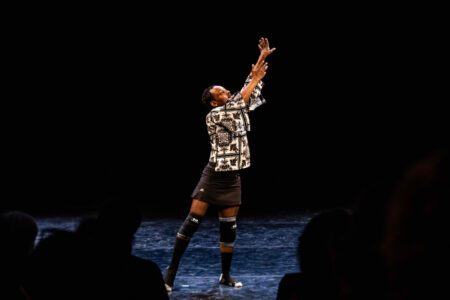
| Location | Goose on a String Theatre / Provazek hall in Brno, Czech Republic |
| Date of Performance | May 23, 2024 |
| Language(s) | English, French, and Spanish |
| Photos by Ivo Dvořák | Alex Mugler |
Reviewed by Amanda L. Andrei
Poisson. Head bob. Poisson. Head bob. Je suis. Hand-chest. Je suis. Hand-chest.
In a simple rhythm, a pair of dancers build gestural language: one speaks into a microphone far downstage, almost in the audience, and the other waits in the center, associating a body motion with the spoken word. As “poisson” (French for “fish”) becomes a dip of the head, other words in French and English follow suit throughout Trio. For the beauty of it. The three dancers of the transnational company La Fleur use spoken language only to transcend speech, all while deftly unveiling their creative process to the audience and celebrating their heritage dance styles.
Director Monika Gintersdorfer and choreographer Franck Edmond Yao, both co-founders of La Fleur, conjure an ingenious space for each dancer to shine individually as well as an ensemble.
The Ivorian choreographer and dancer Ordinateur rises first with coupé-décalé, a style of dance and music originating from the Ivorian diaspora in Paris in the early 2000s. He vibrates with atomic essence, the repetition and speed of his steps so simple and precise that the effect is trancelike. Speaking in French, the dancer also tells us that in Côte d’Ivoire, the slang for this dance is “roukasskass,” a word both crunchy and sibilant that feels in line with the swift drumbeats and Ordinateur’s footsteps.
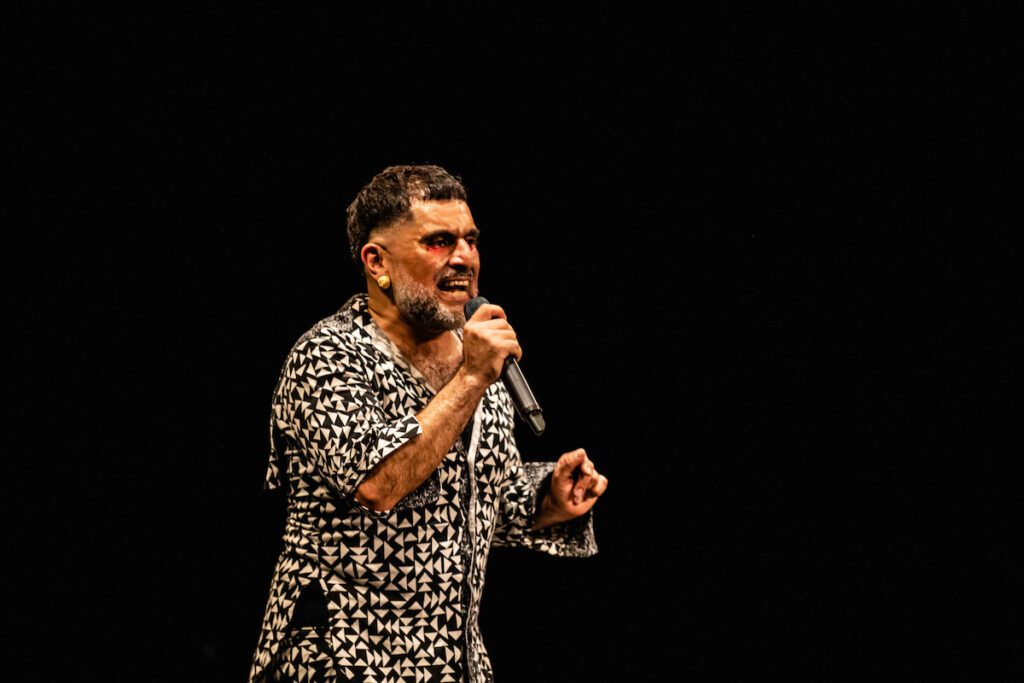
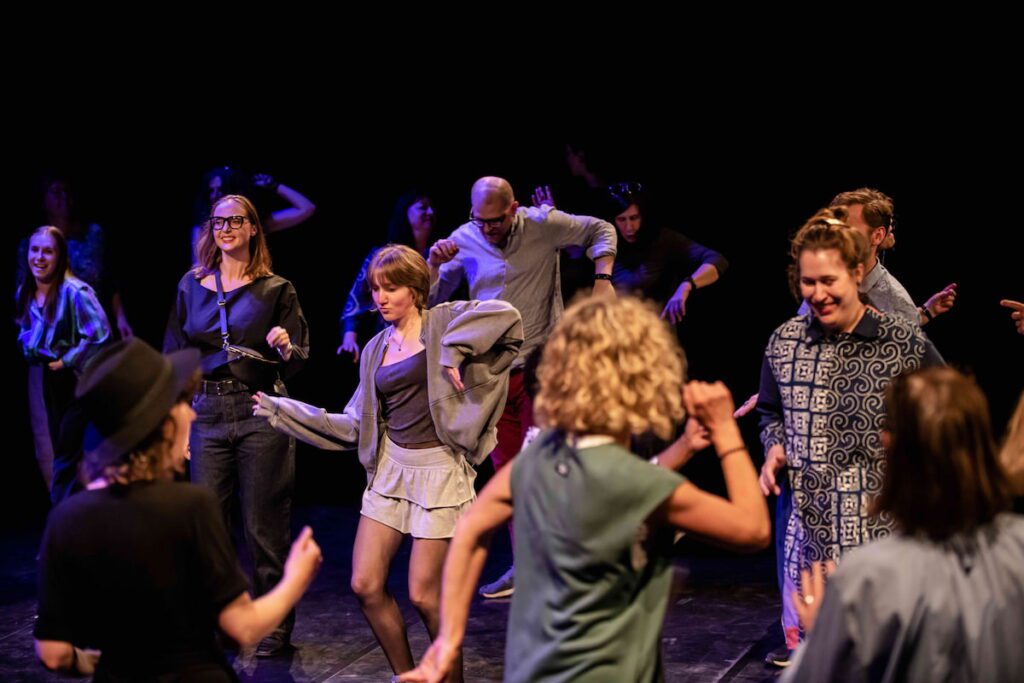
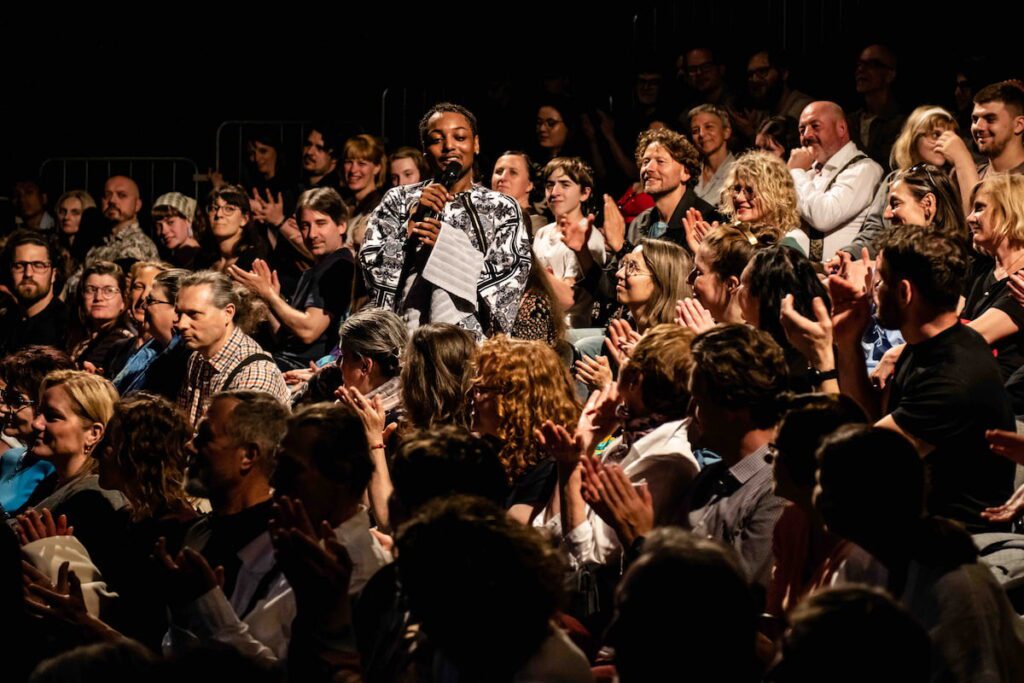
Carlos Gabriel Martínez Veláquez shakes us into cumbia sonidera, a Mexican subgenre of cumbia, a DJ-influenced music and dance style with roots in Latin American and African traditions. To the sounds of salsa guitar licks with an electronica touch, Veláquez spins and quakes with abandon, drawing in the other dancers.
Switching between English and Spanish, the dancer also generously shares meanings of the symbols behind his cultural and artistic influences. Most striking is the idea of the snake, which he tells the audience, “The snake helps us do the right thing in the right moment in the right mode.” In the midst of such festivities, it’s a beautiful reflective moment of how a dancer intuits their next move, how the animal and the divine are present as a source of grace, awareness, and eroticism.
Repping the New York vogue and ballroom scene, Alex Mugler shares with us the dance style developed by queer black and Latine folks of color from the 1960s and onwards in Harlem. With confidence and poise, Mugler’s hands and arms swoop, dive, and flourish before he leaps to the floor, nimbly twisting and posing to loud cheers.
His performance of a song about “kiki”—a slang term from ballroom culture that can refer to the giddiness of a friends’ gossip circle—provides a ticklish moment with a deeper meaning. As the three dancers weave in and out of each other’s space, reciting opposites such as “up, down, right, left,” Mugler sings variations of “let’s have a kiki.” It’s as breezy and fun as spilling tea tends to be, but it also serves as a subtle approach to breaking binaries: we can interrupt our notions of dualism and black-and-white thinking with the frivolity and mercurialness, letting us view the world with more fun and ease.
Towards the end of the hour, Mugler leads Ordinateur and Veláquez in a ballroom dance-off, telling us that we get to judge their skills. It’s another act of generosity to invite us into this world, and we roar with praise for the dancers—who then invite us onstage to romp and whirl with them. And when dancers this skillful encourage you to play and move with them, there’s no hesitation. You dance for the beauty of it.
More information about the Theatre World Brno 2024 Festival (May 17-28) is available here.

Ioana Bîrjan (b.1997) is the author of Vârsta Iubirii which translates into English as The Age of Love (Heyday Books, 2023). The novel is inspired by the Lady of the Camellias and the opera La traviata. She earned a bachelor’s degree from the Faculty of Letters, Ovidius University of Constanța, where she is now a graduate student in the Romanian Studies program.
Read more of her work in magazines, in anthologies, and on her blog: https://scrierileioanei.wordpress.com/
SUPPORT SEEFEST
Not a member yet? Become an art patron with other SEEfest arthouse aficionados in support of great events and programs. Our mission is to keep you informed about initiatives from our wide network of fellow cultural organizations.
We Welcome YOU!
Review: The Ratcatcher
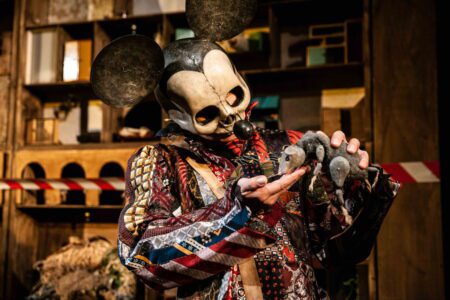
| Location | Radost Theatre in Brno, Czech Republic |
| Date of Performance | May 22, 2024 |
| Language | Czech with English language surtitles |
| Photo by Jakub Jíra | Jiří Skovajsa as Pied Piper. |
Reviewed by Amanda L. Andrei
Once upon a time, there was a small German town named Hamelin. When it became plagued by rats, the mayor sought to eliminate the pests, using cats, traps, and poison. Naturally, when these methods didn’t work, he called in the heavyweight hotshot: a skull-faced Mickey Mouse toting an empty sack and playing a mean recorder.
That’s The Ratcatcher, a clever and intricate adaptation of the Pied Piper fairytale for ages 12 and up, produced by Divadlo Radost in cooperation with the French puppet company, Les Antliaclastes. Performed at the Theatre World Brno Festival, the story expands upon the original folktale with kooky, lush detail and a modern twist.
Early on, the rats emerge from a massive dollhouse-like structure that doubles as the Hamelin neighborhood (designed by Patrick Sims, also director and puppeteer). Each compartment resembles a shadow box: some with miniature furniture, some with musical instruments, some simply plain with wallpaper or a human doll. There’s even a toilet with a cross-section of piping running down the side. The set’s playfulness contrasts against the sinister nature of a huge disease-ridden flea (played by Radim Sasínek) and the crafty mayor (Václav Vítek), each donning superb masks designed by Josephine Biereye.
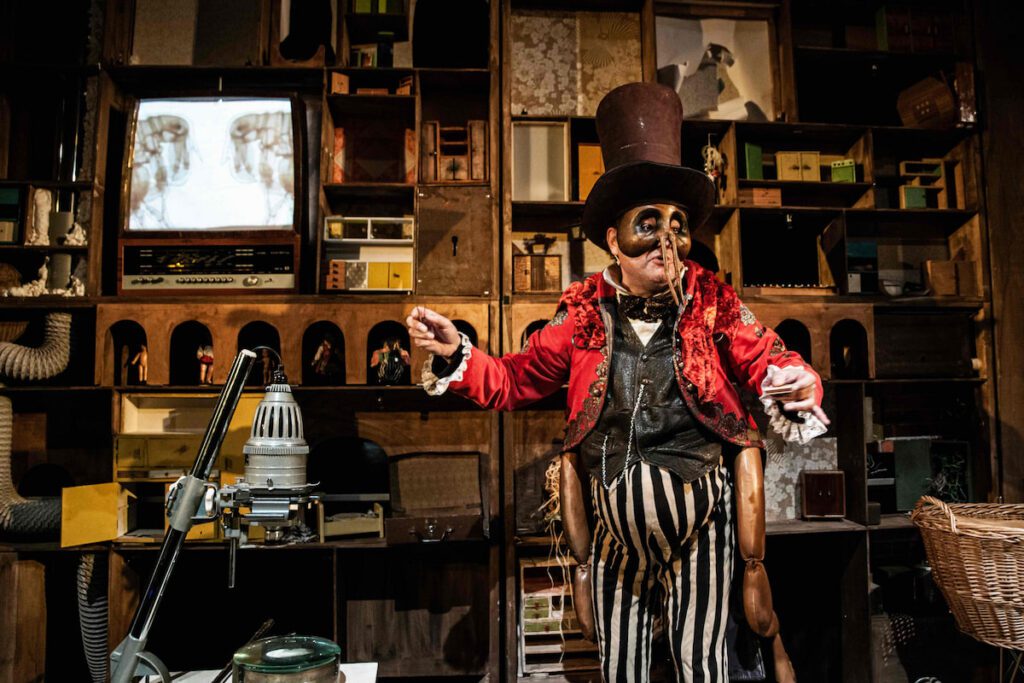
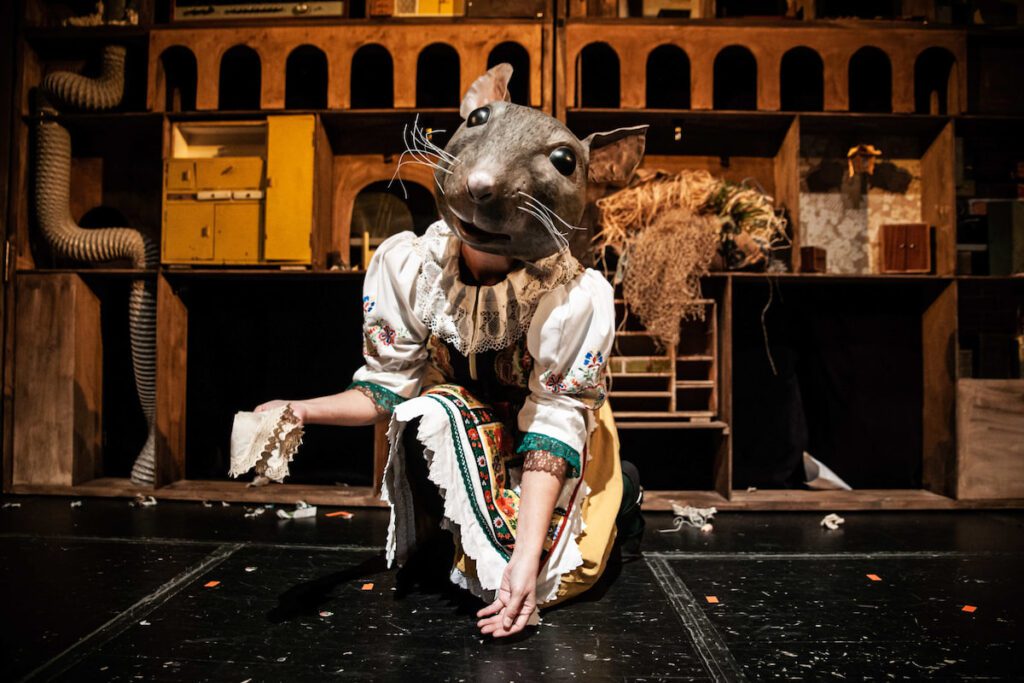
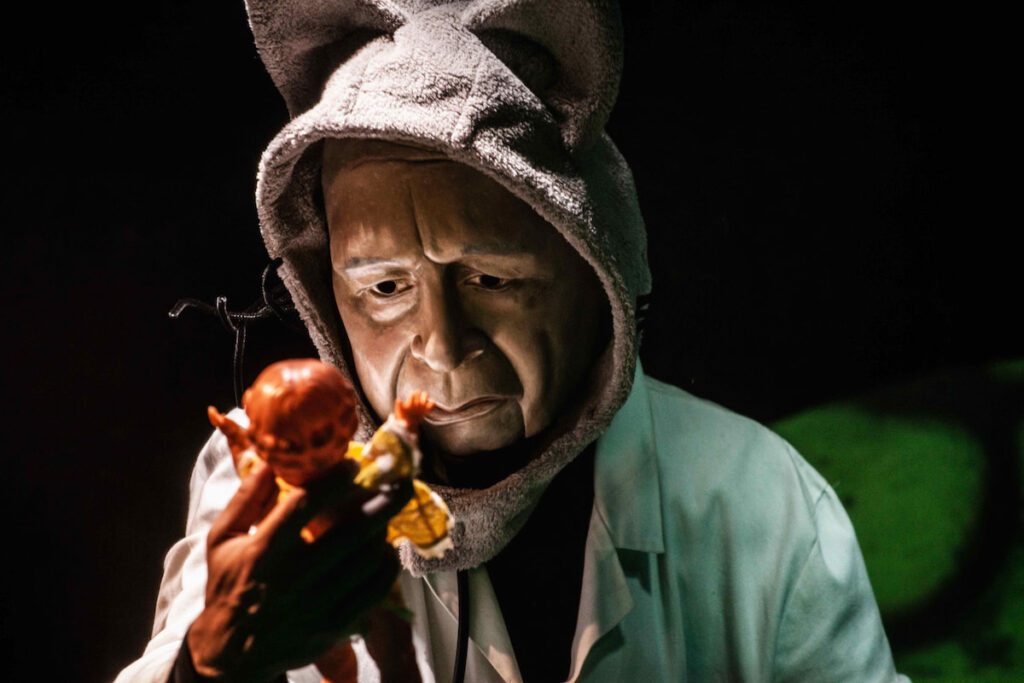
But their sinister nature pales in comparison to the creepiness of the pied piper (Jiří Skovajsa), emanating cutthroat business ideals and greed. In the guise of the notorious Mouse and the specter of Death, he wears a jingling coat of suit ties and seduces the rats (and later, the children) with his music until they plop into his cloth sack and the musical mercenary hopes coins will fill his hand. On their way to death? As a modern fairytale crustacean would croon, “They in for a worser fate.”
As the friendly Rat Girl (Stanislava Havelková) cracks open the house-town with a wooden spoon, the German legend catapults into the satirical sci-fi world of Hamelin Laboratories, where the traitorous mayor—now referred to as Research Director—conducts bizarre experiments on rats and humans.
The exaggerated nature of the puppets (including a robotic feline and a chatty cheese wedge) keep the circumstances comic and cartoonish. Whereas older endings of the narrative focused on disability, death, or despair, Les Antliaclastes and Divadlo Radost take anxieties about the future and present them in a style that is refreshingly weird, thanks to its mashup of fairytale and mad science gone corporate.
There are a few opportunities for growth in the show. For instance, the bit of one rat turning rockstar is so amusing that it deserves an encore. And when the masked Rat Girl plays with unclothed baby dolls from a carriage, it’s unclear if they’re meant to represent living children or everyday toys, making it difficult to establish a sense of attachment for the figurines or their connections to the kidnapped children. These are minor details in an otherwise sensory-rich production and one aimed at adolescents.
The concept could go the direction of George Orwell’s Animal Farm if the company so desired, transforming into a sharp fable about current economic and social conditions. But with a traditional tale already so piercingly macabre, and a Hamelin house-town-lab so lavishly constructed, sharp edges aren’t necessary to enhance the show’s quaint delight. Skeleton Mickey is plenty.
More information about the Theatre World Brno 2024 Festival (May 17-28) is available here.

Ioana Bîrjan (b.1997) is the author of Vârsta Iubirii which translates into English as The Age of Love (Heyday Books, 2023). The novel is inspired by the Lady of the Camellias and the opera La traviata. She earned a bachelor’s degree from the Faculty of Letters, Ovidius University of Constanța, where she is now a graduate student in the Romanian Studies program.
Read more of her work in magazines, in anthologies, and on her blog: https://scrierileioanei.wordpress.com/
SUPPORT SEEFEST
Not a member yet? Become an art patron with other SEEfest arthouse aficionados in support of great events and programs. Our mission is to keep you informed about initiatives from our wide network of fellow cultural organizations.
We Welcome YOU!
Review: MyLifeandMyLife
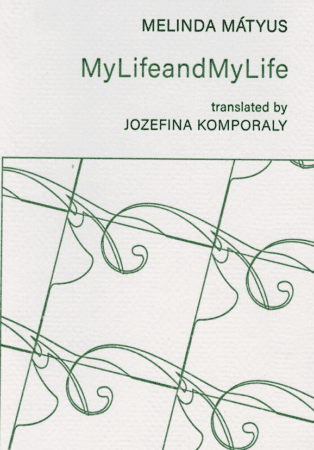
| Author | Melinda Mátyus |
| Genre | Fiction |
| ISBN | 978-1-946604-19-4 |
| Format | 140 pages |
| Language | English |
| Publisher | Ugly Duckling Presse |
Reviewed by Amanda L. Andrei
American poet Emily Dickinson once wrote to a family friend, “The heart wants what it wants – or else it does not care.” Her observation is apt for the stark and bold world of MyLifeandMyLife by Melinda Mátyus. Translated from the Hungarian by Jozefina Komporaly, this experimental novella from the perspective of a nameless woman in a fraught relationship pushes the boundaries of language by expressing the pressure and violence of doomed love.
The unnamed narrator becomes involved with a man named Márton who – despite their sexual relationship – she comes to know less and less. She meets him at movies, but they do not touch. For this woman, love is tantamount to the simplest of gestures, and her words cluster together as if whispered or sighed:
“Hold my hand.
I’dliketoholdyourhand, your hand, I’d like your hand.
I don’t have the courage to utter this.
I’d like my left hand to be in his right hand, so he can touch me with his fingers, first the middle of my palm, then the back of my hand, my wrist, and we canjustwalkandwalk, from one house to another, on and on, then turn around, and around again, cross to the other side, or stay on this side, our side.
To have my lefthandinyourrighthand, that’s what I’d like.” (Mátyus, 15)
Yet her wishes remain unfulfilled. Simplicity is overtaken by excess–in the form of art. In a series of power plays, Márton gifts the narrator expensive paintings that pierce her soul but further separate any semblance of emotional intimacy. “What kind of a world is the one where women fall in love and end up on their own?” she wonders (Mátyus, 16).
It’s a world full of off-colors and uncanny symbols in the artworks, such as blood spurting from a bride and a “whitewashedgrave” (Mátyus, 27). Over the course of a few years, the narrator receives four paintings: Bride’s Door by Helen Frankenthaler, Monitor by Robert Ryman, Running White by Ellsworth Kelly, and Self-Portrait by Paula Modersohn-Becker. It’s notable that the first three paintings are by American abstract artists, while the latter is by a German expressionist painter who was the first woman artist to paint a nude self-portrait (and who died suddenly due to childbirth complications).
The narrator realizes that with these paintings, “Márton is always sending me messages about love because he is incapable of talking about it” (Mátyus, 37). With contempt, she scratches them (her “signature”) with a red stiletto, a small vent of frustration against male expectations of female domesticity and sexuality. Although the final portrait activates her own self-recognition, her lover senses his loss of control, not only over the materiality of his gifts, but over her personhood. The confrontation is as chilling as the narrator’s interpretations of the paintings.
Komporaly’s translation renders a sense of fragility and powerlessness into a character who is wrestling with her contempt and the destructive mystery of eros. Komporaly’s translator’s note and András Visky’s afterword provide additional context to Mátyus’s work, noting the influence of theater and similarities to ancient tragedy. Indeed, with her flowing sentences and huddled words, the novella reads as a stage script for a poetically heightened solo show. It is not hard to imagine watching the narrator as a live actor testifying her innermost secrets, her quotidian observations, and her imminent despair. In a world where women fall in love and end up on their own, it is only their own words that will bear witness to their agony.

Ioana Bîrjan (b.1997) is the author of Vârsta Iubirii which translates into English as The Age of Love (Heyday Books, 2023). The novel is inspired by the Lady of the Camellias and the opera La traviata. She earned a bachelor’s degree from the Faculty of Letters, Ovidius University of Constanța, where she is now a graduate student in the Romanian Studies program.
Read more of her work in magazines, in anthologies, and on her blog: https://scrierileioanei.wordpress.com/
SUPPORT SEEFEST
Not a member yet? Become an art patron with other SEEfest arthouse aficionados in support of great events and programs. Our mission is to keep you informed about initiatives from our wide network of fellow cultural organizations.
We Welcome YOU!
Review: And If I Don’t Behave Then What
Reviewed by Amanda L. Andrei
Open Fist Theatre Company
Through March 4
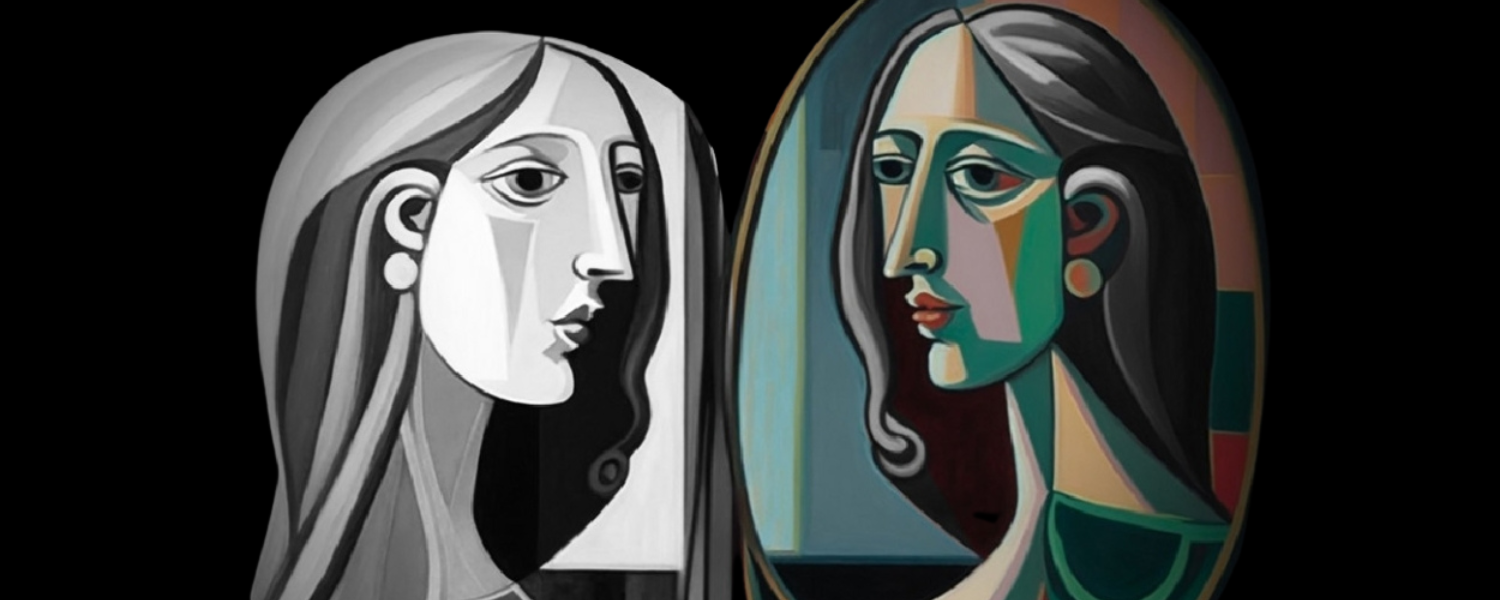
And If I Don’t Behave Then What
L.A. premiere of the new play by Iva Brdar
Ovaries on the concrete. Chin and cheek dimples with the sound of a drill. Being polite, kind, and well-behaved in the face of nameless, insidious forces.
The play consists of various vignettes, starting from Age 0 and culminating when “Woman” is in her 70s. Woman consists of Cynthia Ettinger, reading pages of printed paper or from her phone as she recounts memorable events of a life. However, Woman also consists of Carmella Jenkins, who could be interpreted as a version of a younger self, or another part of the subconscious, and at times Debba Rofheart, the most prominent candidate for the Woman’s mother, voicing the mother’s instructions to her daughter (such as the darkly humorous line, “Don’t sit on concrete, your ovaries will get cold”). And Woman could also consist of Howard Leder, playing the majority of the men’s roles, where the masculine in this world is coldly distant, silent in its brutality, or in a deadpan delivery drawing amusement from the audience, hilarious in its unawareness in giving instructions on how to parallel park.
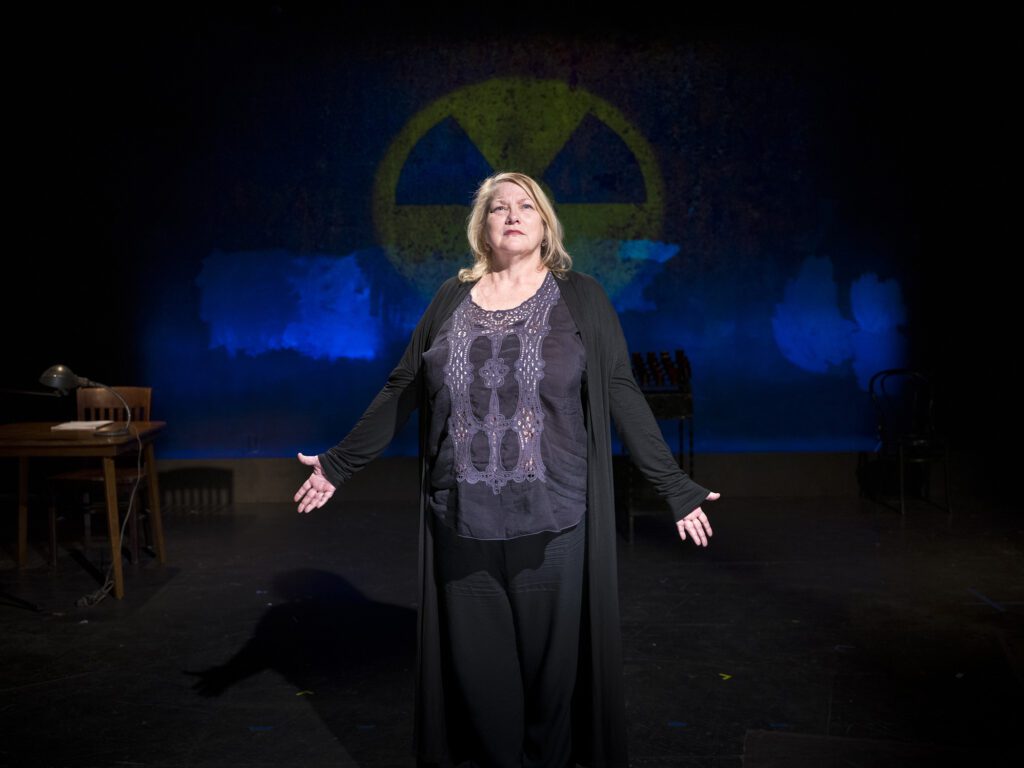
Photo by frank ishman
All these scenes seem to add up to a life that, while portrayed intimately in its details, still feels alienated in the world and to the audience. Rofheart’s “character” (if you can label that part of the text as such) never moves from the seat at the darkened desk, casting a metaphorical shadow of an ever-present yet never-interacted-with mother. And Ettinger has a lovely, soothing voice—when glancing away from the pages, she also serves us lively facial expressions and reactions.
Yet I found myself craving more from the text and questioning the choice to leave the Woman character seemingly on book. Is the Woman a writer or otherwise an intellectual? Is the story so burdensome that it needs an additional interface of pages to separate us from the pain at the heart of these vignettes? From a literary standpoint, these words and images are beautiful, but seeing it performed, I found myself living in my head, the words washing over me, wondering about who the person was behind the text.
And that may be part of the intended effect. I also found myself yearning for more grounding from the playwright’s culture, simultaneously questioning if this world was meant to be a more anonymous post-communist country. The text referenced a former communist country and teaching Marxism, but that could be so much of not only Eastern Europe, but Asia or Latin America as well. I wondered if, from a translation standpoint, there were more words from the original language that could culturally ground the text, or if from a design point, more references to the original culture of the text and its author could be included in the musical transitions or projections—not to exotify, but more to ground an audience member.
Or perhaps that is part of the whole point, that even if the playwright is identified as Serbian, the region has dealt with such a variety of labels, conflict, and grief that perhaps the priority of this performance is not culture, but rather womanhood, the multiplicity of a woman’s life, and the entanglement between mother, daughter, and other knotted ancestral ties and norms packaged up as folk culture to keep us safe. Furthermore, Director Beth F. Milles notes in the program that the piece is written as a “long tone poem” with no punctuation, and so the possibilities for this text are immense. And perhaps this immense tension is what ultimately underlies the piece—that while there are so many possibilities in life, it might still end in a strangely alluring yet alienating mystery.
Atwater Village Theatre is located at 3269 Casitas Ave in Los Angeles, CA 90039. Parking is free is in the ATX (Atwater Crossing) parking lot one block south of the theater.
To purchase tickets and for more information call (323) 882-6912 or go to www.openfist.org.

SUPPORT SEEFEST
Not a member yet? Become an art patron with other SEEfest arthouse aficionados in support of great events and programs, as well as our mission to keep you informed about initiatives from our wide network of fellow cultural organizations.
We Welcome YOU!

